The Solar Cookery Book
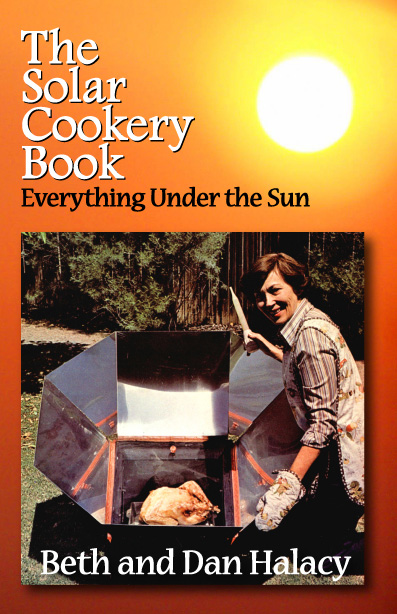
The Solar Cookery Book $19.95
Solar Cookery is entirely about solar cooking, and describes in detail how you can make your own solar oven and reflector hot plate, and how to cook with them. This book will appeal to many kinds of people. It is for people who are interested in conservation and a wise use of our resources, plus a desire to protect the environment. It is for students who are searching for a new project for a science fair. It is also a basic information resource for students who want to learn more about the simple principles that make it possible to put the sun to work in so many useful ways. It is for campers who want a way to cook safely in wooded areas without the need for a fire, or the nuisance of waiting for a fire to get going. No smoke; no ashes. Just clean, hot heat! It is a new horizon for backyard barbecue fans and cookout specialists. It is for health advocates who are seeking ways to put their ideals to practical use. The higher nutritional value of solar-cooked food will be a delight. Perhaps most of all, it is for those who appreciate the fun and excitement of a new way of preparing food.
Solar Cookery was the first book ever available on how to harness the sun's energy in preparing food. If you’re already a solar chef, the cooking tips and recipes in this book will be just as useful for other solar ovens and reflector cookers. Additionally, although this book will obviously appeal to the solar enthusiast, it was not written with only them in mind. Either way, once you discover how easy and enjoyable solar cooking can be, the sun's energy will doubtlessly become a mainstay in your food preparation.
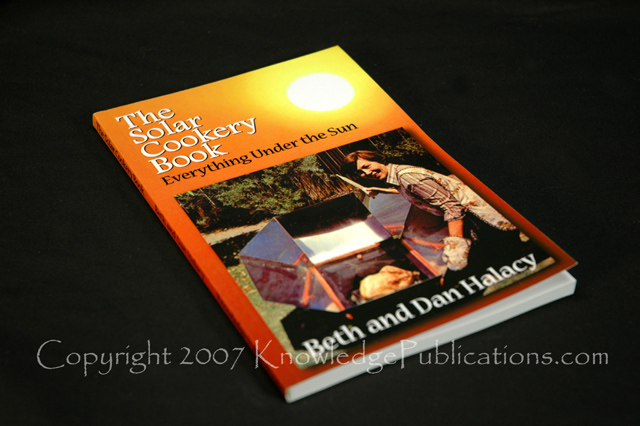 |
Over a century ago August Mouchot, a French scientist, built a solar cooker. This cooker won a large cash prize for being a practical and better way to cook for soldiers in the field. In our own country, scientists like Samuel Pierpont Langley and Charles Abbot built and used solar cookers fifty years ago. So, solar cookery is not as new as you might think. But in general it hasn't been paid much attention to because of cheap fuels. Pioneering solar cooking devices were generally bulky, heavy, and expensive to make. Suitable materials were limited and few people knew about putting the sun to work effectively. Technological advances have made solar cookers and other solar devices more available. Lightweight reflective films and plastics are available at reasonable prices. Practical solar equipment can be bought, or home-built. The result is that every day the sun cooks more hamburgers and even turns out full-course dinners. There are many advantages of cooking with solar energy. Since solar cookers do not require a fire, they are not a fire hazard and can be used in areas closed to fire building. There is no smoke or other pollution from a solar cooker, and no ashes to clean up. Neither is there any wasted time in waiting for a fire to burn down to the proper cooking temperature. Solar cookery is instructive too. After learning how the sun's energy can do everyday chores it is easier to understand how it can do larger tasks, such as home heating or power generation. The basic principles of heat absorption, sun "tracking," and the "greenhouse effect" become easy to understand. Best of all, using solar energy can be a very enjoyable and exciting experience. Some commercial solar cookers are quite expensive, but the two that this book shows you how to build are not. Supplies for the solar oven can be bought for very modest amounts. And if you are a good scrounger you may be able to build them for practically no cash out-of-pocket. Best of all, both projects can be built by amateurs. The potential of solar cooking is unlimited. How about making solar coffee? Or sun-cooked bacon and eggs? Or steak? You can cook a turkey in the solar oven as fast as your electric oven can do it! The second part of Solar Cookery has recipes which have been tested on the solar cookers. You will be able to make entire meals, from soup to dessert, as easily and quickly as you can in the kitchen. Solar cookery saves money too, but far more important is the fact that this kind of cooking is an excellent way to show the great potential of solar energy. The sun grows our food and can cook it as well; that same energy can heat water and keep our houses warm. Some day the sun may provide nearly all our energy — safe and unlimited energy that will clean up our environment and save precious gas and petroleum for better uses. |
Chapter 1: SOLAR ENERGY AND HOW TO USE IT
Turning Sunshine Into Heat
Solar Geography
Chapter 2: BUILDING THE SOLAR OVEN
List of Supplies
The Oven Box
Insulation
Glass Door
Reflectors
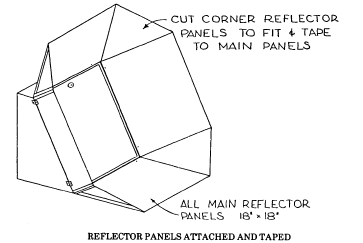
The reflectors can be made several different ways. We've had good results using reflectors made from 1/2" urethane foam with aluminum foil backing. This material (used for home insulation) is very light and not very expensive. In fact, a 4' x 8' sheet costs about $8, and makes a lot of reflectors. Our present oven has reflectors of polished sheet aluminum. We have also used aluminized mylar glued to thin masonite, or other suitable backing material. Just about anything will work as long as you keep it flat, smooth, and shiny. With thin material like sheet aluminum you can make the reflectors fold on hinges. This protects the glass cover while it is not in use and also makes the oven easily portable.
Attachment Angles
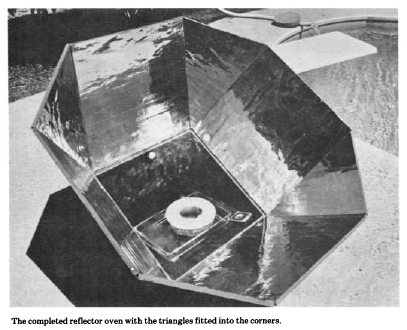
The reflectors are attached to the angles with #10 nuts and bolts, and a 1" washer under the bolt head on the reflector side. This large washer keeps the bolt from pulling through the soft cardboard. Attach all four reflectors, tightening the bolts snugly with screw driver and pliers.
If you have been keeping track of how much additional sunshine the reflectors capture, you know that you are now doubling the amount of solar energy going into the oven, and its temperature will really soar. You can add a bit more heat by filling in the corners as shown in the plans and photos. Cut four cardboard/foil triangles to fit into the gap. Tape them neatly in place with masking tape or duct tape. Now your oven should reach 400° on good days, and that will take care of just about anything you want to cook.
Angle Adjuster
Oven Rack
Using the Solar Oven
The Portable Solar Oven
Chapter 3: BUILDING THE SOLAR HOT PLATE
List of Supplies
How the Solar Hot Plate Works
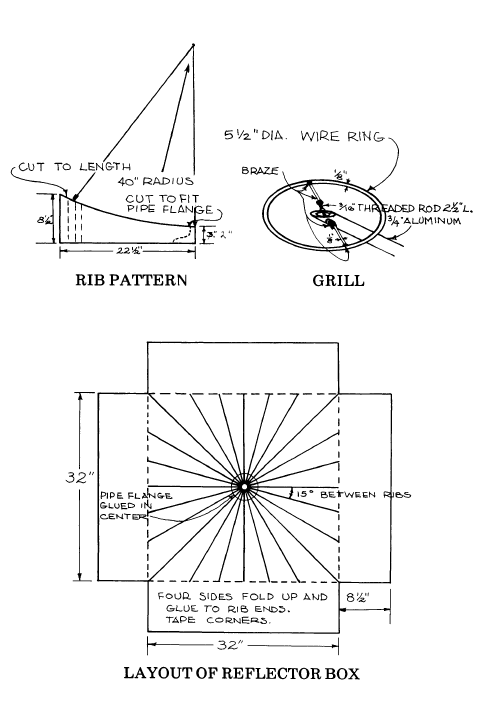
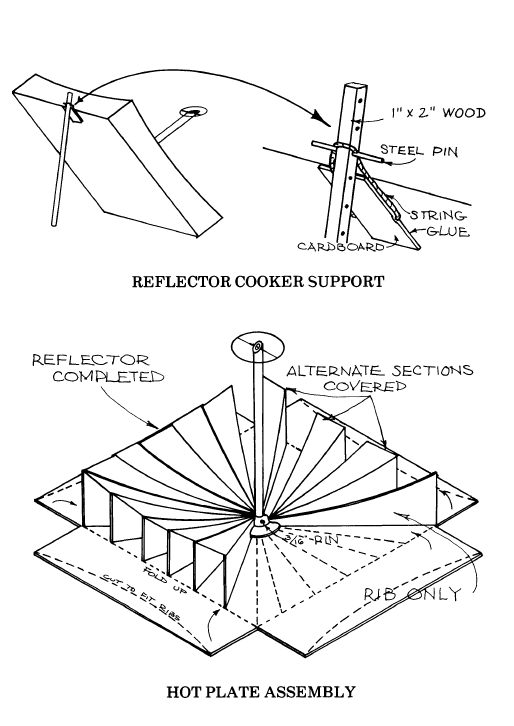
Cardboard Base
Flange Assembly
Making the Ribs
Rib Assembly
Mirror Finish
Reflector Support
The Hot Plate
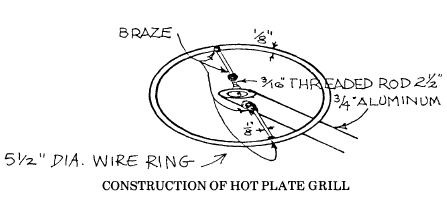 |
The Hot Plate Because of the 40" radius curve of the ribs, the focal length of your reflector should be about 20". On ours we check to make sure. To check, insert the aluminum tubing in the flange and set up the reflector so that there is no shadow from the tubing. This means you are pointing directly at the sun. Now take a piece of wrapping paper about a foot square and cut a hole in the center of it large enough to slide easily over the aluminum tubing. Holding it at the edges, slide the paper onto the tubing and watch the bright, square spot that should be formed by your reflector. Move the paper back and forth until that spot is the smallest you can make it: this will be the focal point of your particular stove. Make a mark on the tubing being careful not to burn yourself on the hot metal. Move it out of the sun and when it is cool cut it to that length, which should be about 20". Now we are ready to install the grill. |
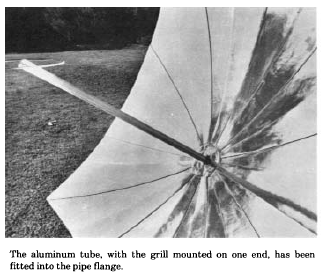 |
Cooking With Sunshine
Tips For Your Solar Hot Plate
Chapter 4: OTHER COOKERS
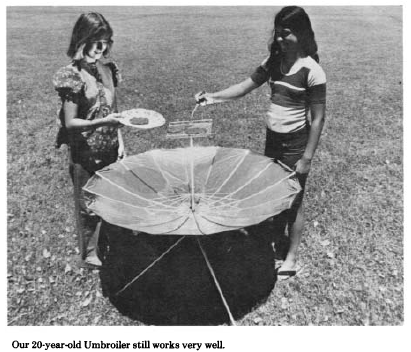 |
Our favorite commercial solar hot plate unfortunately is no longer available. We bought our Umbroiler about 20 years ago and it still works well even though it is a bit frayed around the edges. The invention of Dr. George Liif, a leading solar scientist, it is named for the umbrella it is made from. The beauty of the Umbroiler is that it folds up just like an umbrella. And as someone said, even if it rains you can still use it to keep dry. Easy to carry in the trunk of a car, or even slung over your back, the Umbroiler generates lots of heat and will make coffee, cook hamburgers, hot dogs and steak. It heats water to do the dishes, too. The best commercial solar oven we've used has to be Sam Erwin's Solar Chef. Using real mirrors, it produces high temperatures and will cook just about anything. For fun, Sam built a monster Super Chef twice the size of the standard model. We watched it cook 40 pounds of beef in Phoenix one afternoon for a big solar dinner. We have fitted our Solar Chef with a table top, so that after it has cooked a solar meal we can eat right on top of it. A real conversation piece for back yard or patio, it is quite large and heavy and not the kind of cooker you travel with. |
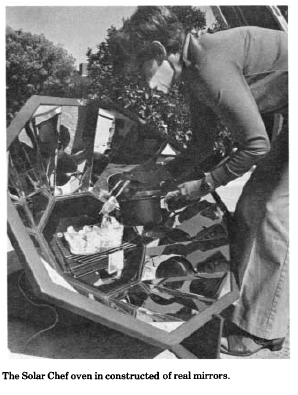 |
Chapter 5: INTRODUCTION TO SOLAR COOKING
Sun
Cookware
Focus
Temperature and Cooking Tips
Pre-heating the Oven
Sunglasses
Oven Racks
Seasons
Geography of Solar Cooking
Weather
Solar Hot Plate Cooking
Symbols
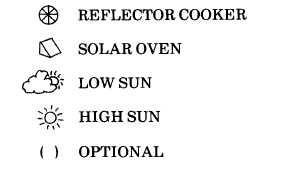
SYMBOLS
The recipes which are keyed for high sun cook the fastest and best on clear sunny days. The cakes and pies should always be cooked as close to noon as possible. The low sun recipes do well in the morning, late afternoon, and in the winter. Some recipes can be cooked with either kind of conditions but they take much longer with low sun, or they might cook faster than you would wish with high sun. Recipes which have not been keyed for either type of sun position can be cooked easily with either high or low sun.
Chapter 6: BREADS
Tips for Bread Baking
Texas Biscuits
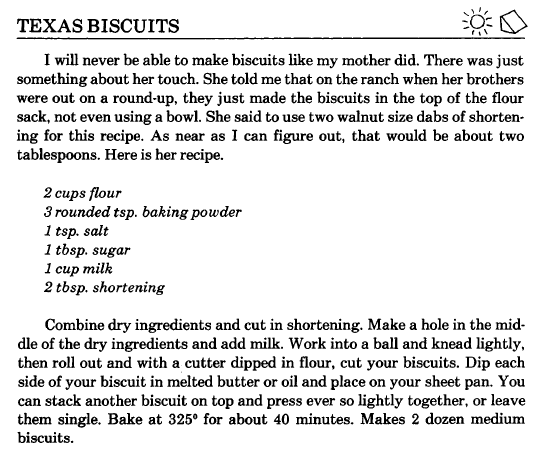
Sourdough Blueberry Muffins
Cereal Muffins
Easy Banana Sandwich Bread
Mexican Spoon Bread
Old-Fashioned Cornbread
Light Rolls
Helen's Wheat Bread
Cornell Bread
French-Italian Bread
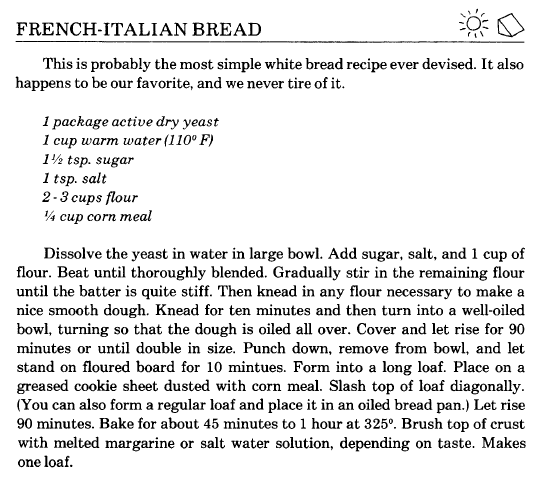
Limpa
Crown Coffeecake
Sourdough Pancakes
Sourdough Hot Rolls
Pizza
Chapter 7: VEGETABLES
Mayonnaise and Yogurt Sauce
Shredded Beets
Grated Carrots
Sauteed Zucchini
Dined Zucchini
Baked Zucchini
Butternut Squash
Green Beans
Potatoes
Italian Fried Lettuce
Corn
Corn Pudding
Cole Slaw
Broccoli and Rice
Artichoke and Lima Beans Supreme
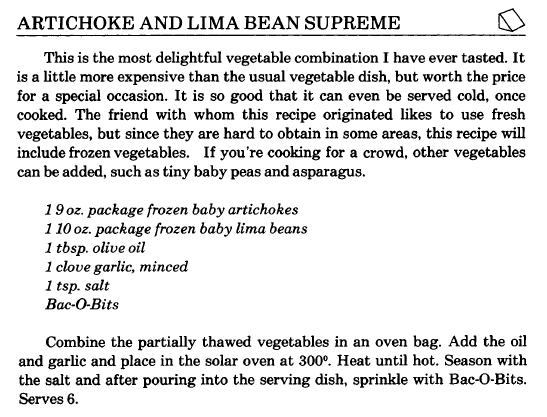
String Beans Supreme
Avocado Soup
Chapter 8: LEGUMES AND GRAINS
Lentils
Split Peas
Cooked Soybeans
Roasted Soybeans
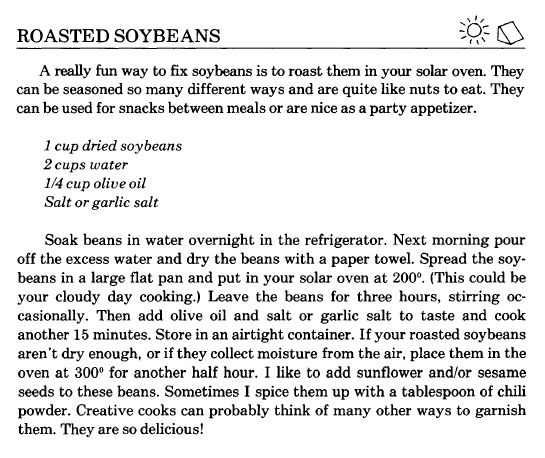
Dried Beans
Oven Rice
Happy Days Rice
Bulgur
Hopping John
Chapter 9: CASSEROLES
Broccoli and Rice Casserole
Quiche Lorraine
Chili Rellenos Bake
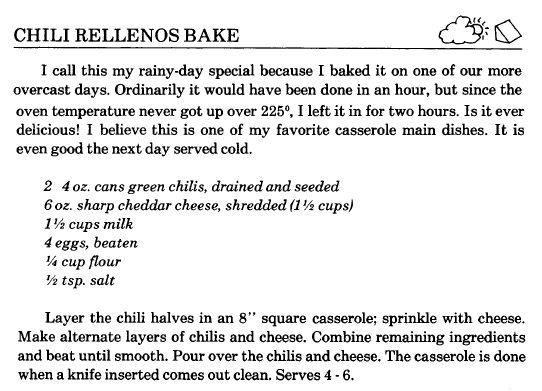
Chili Beef Casserole
Enchilada Casserole
Lasagna
Peggy's Eggplant
Manicotti
Gnocchi
Canneloni
Chapter 10: POULTRY & FISH
Roast Turkey Baste
Turkey and Rice Jubillette
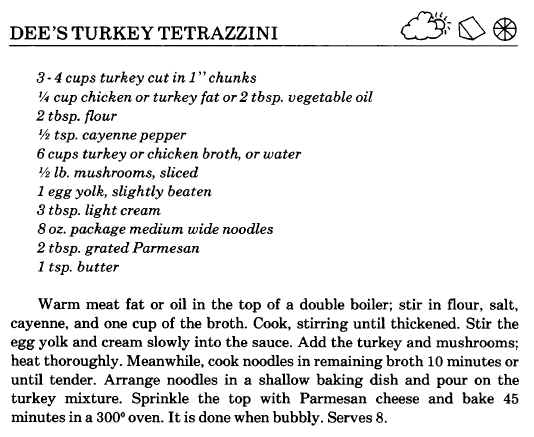
Dee's Turkey Tetrazzini
Turkey Soup
Turkey Almondine
Chicken Barbecue
Cornish Hens
Spaghetti Chicken
Chicken Teriyaki
Baked Haddock or Sole
Baked Red Snapper
Fish Baked in Covered Casserole
Chapter 11: MEAT
Sun Dogs
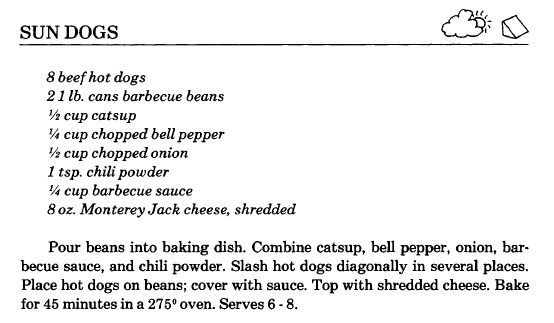
Solar Stew
Swiss Steak and Vegetables
Beef Strips Oriental
Sweet 'N Sour Meatloaf
Mexican Beef
Sunny Southern Pot Roast
Best Ever Barbecue Beef
Lamb Roast
Pork Chops Au Soleil
Fruit-Stuffed Pork Loin
Baked Ham
More
Chapter 12: DESSERTS
Pears Continental
Pear Crisp
Apple Crisp
Strawberry Sand Tarts
Sesame Seed Cookies
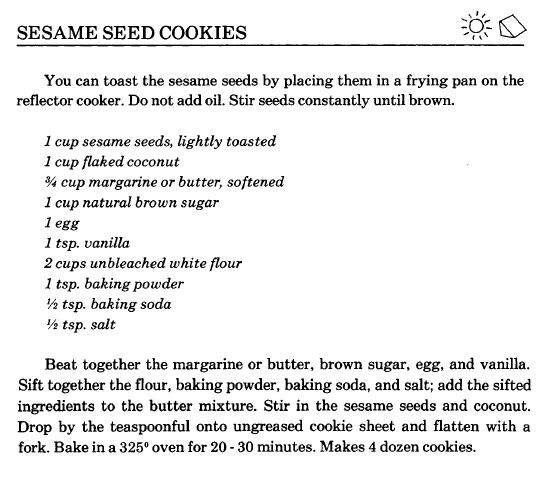
Betty's Molasses Sugar Cookies
Bisquotti
Blond Brownies
Coralee's Date Squares
Coconut Pecan Squares
Sunny Lemon Cake
Carrot Cake
Applesauce Cake
Speedy Solar Chocolate Cake
Zucchini Cake
Black Bottom Cupcake
Apricot Chewies
Oil Pastry
Graham Cracker Pie Crust
Chocolate Shoo Fly Pie
Cheese Pie
Apple Scotch Pie
Solar Equipment & Supplies
Suggested Reading

The Solar Cookery Book $19.95
Solar Cookery is entirely about solar cooking, and describes in detail how you can make your own solar oven and reflector hot plate, and how to cook with them. This book will appeal to many kinds of people. It is for people who are interested in conservation and a wise use of our resources, plus a desire to protect the environment. It is for students who are searching for a new project for a science fair. It is also a basic information resource for students who want to learn more about the simple principles that make it possible to put the sun to work in so many useful ways. It is for campers who want a way to cook safely in wooded areas without the need for a fire, or the nuisance of waiting for a fire to get going. No smoke; no ashes. Just clean, hot heat! It is a new horizon for backyard barbecue fans and cookout specialists. It is for health advocates who are seeking ways to put their ideals to practical use. The higher nutritional value of solar-cooked food will be a delight. Perhaps most of all, it is for those who appreciate the fun and excitement of a new way of preparing food.
Solar Cookery was the first book ever available on how to harness the sun's energy in preparing food. If you’re already a solar chef, the cooking tips and recipes in this book will be just as useful for other solar ovens and reflector cookers. Additionally, although this book will obviously appeal to the solar enthusiast, it was not written with only them in mind. Either way, once you discover how easy and enjoyable solar cooking can be, the sun's energy will doubtlessly become a mainstay in your food preparation.

